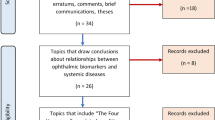Abstract
Objective
To determine normal values for pupillometry indices in healthy control subjects and to examine these indices in patients with autonomic dysfunction and healthy controls.
Methods
Infrared video pupillometry was used to investigate the pupil response to a brief light flash in 79 healthy controls, 28 patients with normal autonomic function (composite autonomic severity score, CASS < 2), and 26 patients with moderate to severe autonomic failure (CASS > 4) seen in our autonomic laboratory from January 2008 to June 2011. In six subjects, we examined the effects of varying light stimulus intensity and light stimulus duration. Descriptive analysis, correlation, and ANCOVA adjusted for age were performed.
Results
We determined eight indices corresponding to parasympathetic and sympathetic pupil function. Baseline pupil diameter (BPD), maximum constriction velocity (MCV), absolute constriction amplitude (ACA), and maximum dilation velocity (MDV) negatively correlated with age (p < 0.01) among controls. MCV and ACA increased with increasing intensity of light stimulus from 3.5 to 112 μW. Indices of parasympathetic pupil innervation (MCV and ACA) were lower in the high CASS group compared to others (p < 0.0001). Indices of sympathetic pupil function, time to reach 75 % of initial resting diameter during pupillary dilation (T¾), and dilation velocity at T¾ (DV¾) did not differ significantly in the three study groups. However, T¾ corrected for the magnitude of pupillary constriction (T¾:ACA) was higher in the high CASS group suggesting sympathetic dysfunction in that group (p = 0.0003).
Conclusions
Indices of pupillomotor function significantly differ between patients with moderate to severe autonomic failure and healthy controls.




Similar content being viewed by others
References
Ravits JM (1997) AAEM minimonograph #48: autonomic nervous system testing. Muscle Nerve 20(8):919–937. doi:10.1002/(SICI)1097-4598(199708)20:8<919:AID-MUS1>3.0.CO;2-9
Bremner F (2009) Pupil evaluation as a test for autonomic disorders. Clin Auton Res 19(2):88–101. doi:10.1007/s10286-009-0515-2
Bremner F, Smith S (2006) Pupil findings in a consecutive series of 150 patients with generalised autonomic neuropathy. J Neurol Neurosurg Psychiatry 77(10):1163–1168. doi:jnnp.2006.09283310.1136/jnnp.2006.092833
Bremner F, Smith S (2008) Pupillographic findings in 39 consecutive cases of Harlequin syndrome. J Neuroophthalmol 28(3):171–177. doi:10.1097/WNO.0b013e318183c88500041327-200809000-00002
Ferrari GL, Marques JL, Gandhi RA, Heller SR, Schneider FK, Tesfaye S, Gamba HR (2010) Using dynamic pupillometry as a simple screening tool to detect autonomic neuropathy in patients with diabetes: a pilot study. Biomed Eng Online 9:26. doi:1475-925X-9-2610.1186/1475-925X-9-26
Mukherjee S, Vernino S (2007) Dysfunction of the pupillary light reflex in experimental autoimmune autonomic ganglionopathy. Auton Neurosci 137(1–2):19–26. doi:S1566-0702(07)00116-610.1016/j.autneu.2007.05.005
Muppidi S, Scribner M, Gibbons CH, Adams-Huet B, Spaeth EB, Vernino S (2012) A unique manifestation of pupillary fatigue in autoimmune autonomic ganglionopathy. Arch Neurol. doi:archneurol.2011.214310.1001/archneurol.2011.2143
Giza E, Fotiou D, Bostantjopoulou S, Katsarou Z, Karlovasitou A (2011) Pupil light reflex in Parkinson’s disease: evaluation with pupillometry. Int J Neurosci 121(1):37–43. doi:10.3109/00207454.2010.526730
Giza E, Fotiou D, Bostantjopoulou S, Katsarou Z, Gerasimou G, Gotzamani-Psarrakou A, Karlovasitou A (2012) Pupillometry and 123I-DaTSCAN imaging in Parkinson’s disease: a comparison study. Int J Neurosci 122(1):26–34. doi:10.3109/00207454.2011.619285
Lowenstein O, Loewenfeld IE (1950) Mutual role of sympathetic and parasympathetic in shaping of the pupillary reflex to light: pupillographic studies. Arch Neurol Psychiatry 64(3):341–377
Smith SA, Smith SE (1999) Bilateral Horner’s syndrome: detection and occurrence. J Neurol Neurosurg Psychiatry 66(1):48–51
Low PA (1993) Composite autonomic scoring scale for laboratory quantification of generalized autonomic failure. Mayo Clin Proc 68(8):748–752
Low PA, Benrud-Larson LM, Sletten DM, Opfer-Gehrking TL, Weigand SD, O’Brien PC, Suarez GA, Dyck PJ (2004) Autonomic symptoms and diabetic neuropathy: a population-based study. Diabetes Care 27(12):2942–2947. doi:27/12/2942
Low PA, Denq JC, Opfer-Gehrking TL, Dyck PJ, O’Brien PC, Slezak JM (1997) Effect of age and gender on sudomotor and cardiovagal function and blood pressure response to tilt in normal subjects. Muscle Nerve 20(12):1561–1568. doi:10.1002/(SICI)1097-4598(199712)20:12<1561:AID-MUS11>3.0.CO;2-3
Bremner FD (2012) Pupillometric evaluation of the dynamics of the pupillary response to a brief light stimulus in healthy subjects. Invest Ophthalmol Vis Sci 53(11):7343–7347. doi:10.1167/iovs.12-10881
Koelewijn T, Zekveld AA, Festen JM, Kramer SE (2012) Pupil dilation uncovers extra listening effort in the presence of a single-talker masker. Ear Hear 33(2):291–300. doi:10.1097/AUD.0b013e3182310019
Vinik AI, Maser RE, Mitchell BD, Freeman R (2003) Diabetic autonomic neuropathy. Diabetes Care 26(5):1553–1579
Conflict of interest
On behalf of all authors, the corresponding author states that there is no conflict of interest.
Author information
Authors and Affiliations
Corresponding author
Rights and permissions
About this article
Cite this article
Muppidi, S., Adams-Huet, B., Tajzoy, E. et al. Dynamic pupillometry as an autonomic testing tool. Clin Auton Res 23, 297–303 (2013). https://doi.org/10.1007/s10286-013-0209-7
Received:
Accepted:
Published:
Issue Date:
DOI: https://doi.org/10.1007/s10286-013-0209-7




